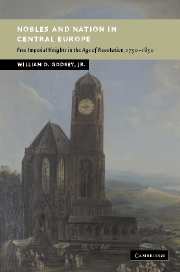Book contents
- Frontmatter
- Contents
- Preface
- Abbreviations
- Introduction
- 1 Wealth and noble autonomy: the Free Imperial Knights in Mainz on the eve of revolution
- 2 Nobles becoming Germans: the transformation of a concept
- 3 Nobles becoming Germans: the destruction of a “geo-cultural landscape”
- 4 Between destruction and survival: knights on the Middle Rhine 1750–1850
- 5 The past recaptured: knights in the Hapsburg Empire 1792–1848
- 6 From cathedral canons to priests: the Coudenhoves and the “Catholic revival”
- 7 The beginnings of conservative German nationalism: the “naturalization” of Baron Carl vom und zum Stein (1757–1831)
- Conclusion
- Appendix: Families of Free Imperial Knights (1797)
- Bibliography
- Index
Appendix: Families of Free Imperial Knights (1797)
Published online by Cambridge University Press: 01 October 2009
- Frontmatter
- Contents
- Preface
- Abbreviations
- Introduction
- 1 Wealth and noble autonomy: the Free Imperial Knights in Mainz on the eve of revolution
- 2 Nobles becoming Germans: the transformation of a concept
- 3 Nobles becoming Germans: the destruction of a “geo-cultural landscape”
- 4 Between destruction and survival: knights on the Middle Rhine 1750–1850
- 5 The past recaptured: knights in the Hapsburg Empire 1792–1848
- 6 From cathedral canons to priests: the Coudenhoves and the “Catholic revival”
- 7 The beginnings of conservative German nationalism: the “naturalization” of Baron Carl vom und zum Stein (1757–1831)
- Conclusion
- Appendix: Families of Free Imperial Knights (1797)
- Bibliography
- Index
Summary
Following is a list of 359 families that belonged to the Free Imperial Knights at the end of the eighteenth century. The names are taken from tables drawn up at the time of the Congress of Rastatt for the six Franconian cantons, the five Swabian cantons and the affiliated district of Ortenau, and two of the three Rhenish cantons (Upper Rhine and Middle Rhine). The table drawn up for Canton Lower Rhine unfortunately does not make a distinction between the actual members of the canton and those who merely owned land under its jurisdiction. Names from the Lower Rhenish list are therefore not included below.
The table for the Swabian Canton Hegau-Allgäu-Bodensee divides the member-families into the two districts Hegau and Allgäu-Bodensee. These districts together formed the canton.
The other tables used as the source for this list apparently included only the landed member-families of the cantons and excluded those members who were not landed (called Personalisten). If there were approximately the same number of landed member-families in Lower Rhine as in the other two Rhenish cantons — Canton Middle Rhine had seventy-five families and Canton Upper Rhine seventy-seven families — then the total number of landed member-families of the Free Imperial Knights (359 + 75) must have been around 430.
If the non-landed members (Personalisten) are factored in, then the total number of member-names of the Free Imperial Knights may have been 500 or more, as another list drawn up in the 1830s would suggest.
- Type
- Chapter
- Information
- Nobles and Nation in Central EuropeFree Imperial Knights in the Age of Revolution, 1750–1850, pp. 255 - 265Publisher: Cambridge University PressPrint publication year: 2004

